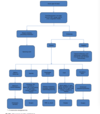Ch. 48 Bloody Emesis Flashcards
What Variables Adversely Affect Prognosis in a patient with an upper GI bleed?
- Increasing age > 60 yrs
- Comorbid conditions (renal failure, liver failure, heart failure)
- Variceal bleeding
- Shock on presentation
- Increasing # of units of blood transfused
- Active bleeding during endoscopy
- Bleeding from a large (>2.0 cm) ulcer
- Recurrent bleeding
What are esophageal varices?
Dilated tortuous veins located in submucosa of distal 3rd of esophagus (form as a result of portal HTN)…. high pressure, superficial location… highly prone to erode –> life-threatening bleed
Retrograde flow due to cirrhosis:
Portal vein –> L gastric (coronary) vein/esophageal vein
Acute vs. Chronic gastritis:
Erosive?
Etiology?
Pathogenesis?
Acute - EROSIVE, superficial inflammation in lining of stomach 2/2 dysfunction of mucosal defenses (production of prostaglandins, bicarbonate, somatostatin… all three reduce inflammatory effects of gastric acid)

What is Dieulafoy’s Lesion?
Rare cause of acute upper GI bleed –> vascular malformation (large tortuous artery in submucosa.. often in lesser curvature of stomach… eroded by gastric acid)
Finding on endoscopy: small, pinpoint defect in gastric mucosa (visible vessel w/o underlying ulcer present).. not a primary ulcer but likely a result of mechanical pressure from pulsating large artery that progressively erodes through mucosa

Bleeding vessels in peptic ulcer disease
Branches of celiac trunk –> subject to erosion –> severe hemorrhage if ulcer penetrates through GI mucosa and into vessel

Workup:
Why might hemoglobin/hematocrit be normal in spite of a major GI bleed?
Hematocrit = poor indicator of severity of acute blood loss… since pt is losing whole blood, plasma AND red cell volume decrease in same proportion (hematocrit may not change at all initially)
Decrease may not reflect until 12-24 hrs later when kidney begins to conserve sodium and water
Over time, pt’s Hb will decrease further as fluid is administered with initial resuscitation
What happens to BUN/Creatinine ratio during UGI bleed?
Increases
Result of absorption of degraded blood products during intestinal transit and prerenal azotemia 2/2 hypovolemia
What part of the GI tract is considered an upper GI bleed?
Oropharynx –> distal duodenum (at ligament of Treitz)
LIT - marks transition from retroperitoneal duodenum to intraperitoneal jejunum
If a patient presents with bloody emesis and BRBPR, is it an upper or lower GI bleed?
BRBPR usually due to lower GI bleed
However, massive UGI bleeding may cause such a rapid transit of blood through GI tract that it does not have time to be subjected to digestive enzymes —> result: BRBPR
What is the difference between obscure and occult GI bleeding?
Occult = one that is not known to the patient. It is discovered by either fecal occult blood testing or by noting an iron deficiency anemia on blood testing. Majority of causes of both upper and lower GI bleeding can present as occult bleeding
Obscure = obvious bleeding that is known to pt but source is hard to identify despite endoscopy –> tends to arise from pathology in small bowel (lymphoma, leiomyoma, leiomyosarcoma, small bowel varices, crohn’s, TB…)
Management?
What are the first steps in mgmt of pt with upper GI bleed?
Fluid resuscitation if hemodynamically instable (hypotension, tachy, active bleed)
- Two large-bore IV lines
- NGT
- Help differentiate between upper and lower GI bleed
- If NGT lavage returns blood or coffee grounds –> upper
- If clear, nonbilious fluid… –> source unlikely to be proximal to pylorus
- NGT lavage facilitates proper visualization during endoscopy as it removes fresh blood and blood clots
- Blood sent for a type & cross
ESSENTIAL PRIOR TO ENDOSCOPY!

Mgmt:
What fluid is used during NGT Lavage?
Room-temperature normal saline = preferred irrigant
(traditionally, iced lavage was used b/c it was believed to help decrease bleeding by promoting vasconstriction in nearby vessels… this has fallen out of favor b/c cold solutions stimulate vagus n. –> lead to increased acid secretion and gastric motility –> exacerbate bleeding)
What are the indications for surgery in a patient with an UGB? (5)
- Failure of endoscopic therapy (usually after 2 attempts)
- Persistent hemodynamic instability despite aggressive resuscitations
- CVD w/ predictive poor response to hypotension
- Hemorrhagic shock
- Excluding esophageal varices
What are the surgical options in a patient with a bleeding ulcer that fails medical mgmt?
Duodenal: open longitudinally –> oversew bleeding ulcer in three quadrants, make sure bleeding gastroduodenal artery is properly ligated
Gastric: excise part of stomach to include ulcer, higher risk of underlying malignancy
How does mgmt of UGI bleed differ for esophageal varices?
Variceal bleeding managed with short-term antibiotic ppx (decreases infection risk)
Endoscopic band ligation = first choice recommendation (less injury to esophagus as opposed to cauterization/coagulation)
Somatostatin to reduce portal blood flow

